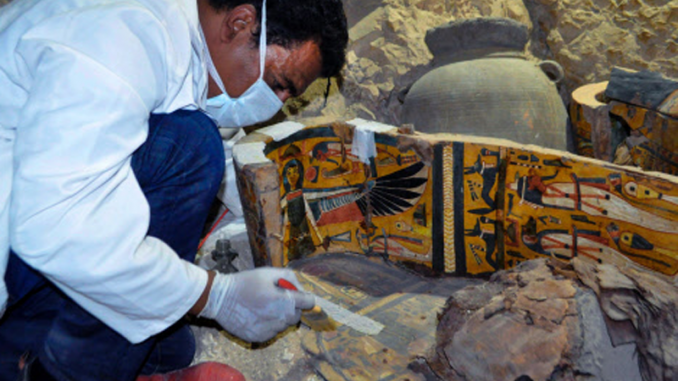
Egyptian archaeologists have unearthed several mummies, colorful wooden sarcophagi and more than 1,000 funerary statues in a 3,500-year-old tomb near the city of Luxor.
They have hailed their find an “important discovery”.
Press TV reports:

BYPASS THE CENSORS
Sign up to get unfiltered news delivered straight to your inbox.
You can unsubscribe any time. By subscribing you agree to our Terms of Use
The 18th Dynasty tomb containing at least eight mummies was discovered in the Draa Abul Nagaa necropolis near the famed Valley of the Kings, the antiquities ministry said in a Tuesday statement.
It belonged to a nobleman named Userhat who worked as the city judge. It was opened to add more mummies during the 21st Dynasty, about 3,000 years ago, to protect them during a period when tomb-robbing was common, Mostafa Waziri, the head of the archaeological mission, said at the site.
Ushabti figurines were often placed with the deceased in ancient Egyptian tombs to help with responsibilities in the afterlife.
Antiquities officials had initially said six mummies along with partial remains were discovered near the southern city, but said they had later identified two more mummies.
“There are 10 coffins and eight mummies. The excavation is ongoing,” Waziri said.
Inside the tomb, archaeologists wearing white masks and latex gloves inspected the sarcophagi, which were covered with intricate drawings in red, blue, black, green, and yellow, and featured the carved faces of the dead.
The coffins were mainly well-preserved, though some had deteriorated and broken over the years.
Archaeologists were also examining a mummy wrapped in linen which was inside one of the coffins.
White, orange, green, and patterned pots were also found in the tombs.
The necropolis is located across the Nile from Luxor, on the west bank, where many of the famous ancient Egyptian pharaohs were buried, including Tutankhamun.
The age of the tomb was determined “through the drawings on the ceiling,” said Waziri.
A nine-meter shaft inside the tomb held the Ushabti figurines, as well as “wooden masks and a handle of a sarcophagus lid,” the ministry said.
Waziri said the mummies dated back to an age called “the era of the tomb robbers.”
Another room in the tomb was also discovered, though it has not yet been completely excavated, the ministry said.
Archaeologists were able to enter the tomb “after removing almost 450 meters of debris out of the open court,” it added.
The tombs and ancient temples of Thebes, the capital of ancient Egypt during its later periods and now the city of Luxor, have been a major tourist attraction.
Nevine el-Aref, the spokeswoman for the antiquities ministry, said “there is evidence and traces that new mummies could be discovered in the future” at the site.
(Source: AFP)


Be the first to comment